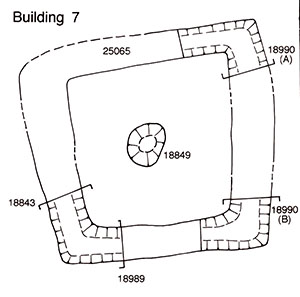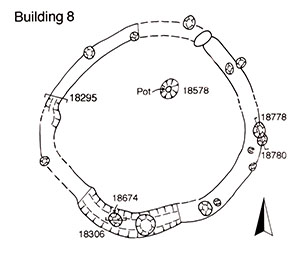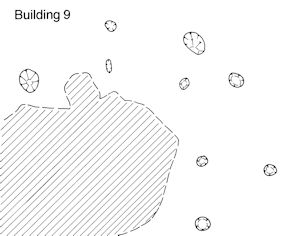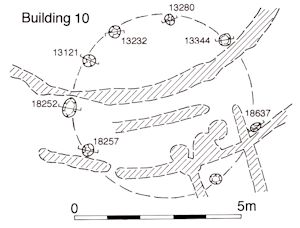
The various ditches that define the enclosure system imposed upon the southern part of the lower gravel terrace are described in Lower terrace (south). Activity within Open Area 1 - a somewhat notional entity at the west end of the investigated part of the terrace - is described here. Largely unbounded, this vicinity contains a very distinct cluster of square and circular post-built buildings at the heart of what is later developed into the temple complex. A relatively high frequency of pitting is also evident here. Whether this is simply the result of a lack of overlying stratigraphy and extensive investigation within Excavation Area J, or a real product of OA1 function, is unclear. The contents of the pits shed little light on the posited religious function of at least some of the buildings within OA1, though the final infilling of some of these hints at an episode of clearance of the Period 2A structures prior to the remodelling and creation of a temple complex in Period 2B.

Building 7 (Group 13) is a small, square building defined by 1m-wide foundation trench 25065 (segs 18769, 18808, 18843, 18871, 18990, 21025) (Figure 9). The foundation trench is relatively deep at 0.45m. The upper parts of the sides of the cut are splayed, but the lower part of the trench is in effect a vertically sided slot some 0.3m wide. It is likely that the walls of this building were constructed of close-set planks, of substantial thickness, placed upright side-by-side in the trench. The internal space of the building measures c. 4.5m square. There is no indication of the position of a doorway.
The foundation backfills (seg. 18871) contain a jar form that is dated to the late 1st century BC at Kelvedon (Rodwell 1988, fig. 79, nos 19-22). The other small amounts of sand- and grog-tempered pottery are consistent with this date.
A circular pit 18849 (Group 14), 1.20m in diameter and 0.80m deep, is positioned in the centre of the building. Its dark sand-silt fill contains only a small quantity of late 1st century BC pottery, animal bone and a blue glass bead (SF7281).

Building 8 (Figure 10) consists of a shallow slot, 25068 (segs 18291, 18295, 18306, 18792, 21015 Group 15). It defines a circle of c. 6.00m diameter with a series of post-holes (between 0.2-0.6m in diameter) set in its base (Group 16). The post-holes within the slot were irregularly spaced, although the two largest (18701, 18881) could possibly indicate the position of a south-facing doorway. The dating evidence from the structural remains is confined to a small quantity of undiagnostic Late Iron Age grog-tempered pottery.
A small (0.27m diameter and 0.11m deep) pit 18578 (Group 17) is positioned in the north-eastern quadrant of the interior of Building 8. A complete grog-tempered jar is placed upright within it. The vessel is wheel-finished and roughly decorated with looped combing, a form that is dated to the second half of the 1st century BC at Kelvedon (Rodwell 1988, fig. 79, no. 32). Being an isolated and exceptional find, it is interpreted as a votive offering inserted into the floor of the building. The dating of this vessel is taken as indicating the period of use of Building 8 as being in the second half of the 1st century BC.
A dense concentration of post-holes lies to the north and south of Building 8. On stratigraphic and morphological criteria, augmented by scarce dating evidence, some of these can be construed as further Period 2A structures lying to the west of Building 7. It should be stressed, however, that the evidence for Buildings 9 and 10 is inconclusive and that these buildings represent only one, tentative, interpretation of it. Building 9 pre-dates Building 10, which itself is dated to the second half of the 1st century BC.

Building 9 (Group 18) comprised two concentric circles of post-holes, the outer with a radius of 3.75m, the inner c. 2.5m (Figure 12). While some of these post-holes clearly pre-date Period 2B Buildings 34 and 52, others have neither stratigraphic nor artefactual dating evidence. Some contain clayey fills and all are truncated; whether this is due simply to machining of the area, or occurred as part of the clearance that preceded the deposition of the Period 2B surfaces in this part of the site is uncertain. Post-hole 13070, with its burnt content, perhaps resulting from demolition activity prior to reconstruction, may suggest the latter. The suggested plan of Building 9 intersects that of Building 10. Building 9 appears to be the earlier and the fact it centres on what later becomes the location of plinth structure 5811 (Period 3) would appear to be coincidental.

Building 10 (Group 19) is a post-built, circular building of some 5m diameter (Figure 13). The constituent post-holes (13121, 13232, 13280, 13344, 18252, 18257, 18637) are of similar sizes and some clearly pre-date the Period 2B temple buildings. The fills of two (18252, 18257) contain grog-tempered pottery. The jar sherds in 18252 are handmade, and one of these is also tempered with sand. A date in the second half of the 1st century BC is indicated.

The features defining Building 11 (Figure 14) are construed to be arranged around a central post-hole 18315 and to form the northern half of a circular, post-built building some 7.00m in diameter. The southern part of Building 11 lies under an unexcavated part of Period 2B Road 3. The constituent post- or stake-holes are only 0.15-0.25m diameter and relatively shallow (most under 0.15m). If real, it is doubtful that Building 11 can be contemporary with Building 8, which lay immediately to its north, but the relative sequence is not established. The only dating evidence is pottery in grog-tempered fabric from post-hole 18674, which is a slight outlier to the circular arrangement.
The pits in the general vicinity of Buildings 7 and 8 (Groups 22, 23) are generally large and shallow features (in excess of 2m wide and only 0.2-0.4m deep ) cut into the underlying sand and gravel. Many contain remarkably similar fills of mid- to dark brown sandy silts overlain by charcoal-rich deposits. It is postulated that these upper, black, deposits are the remnants of more extensive layers, rather than fills; probably the product of a destruction episode that preceded the remodelling of the area toward the mid-1st century AD. Fill 5211 of pit 5220 is subject to soil micromorphology analysis.
The primary function of these pits is not indicated by the sparse artefact assemblages in their fills, which included small quantities of pottery and animal bone as their principal components. Although the pottery is largely undiagnostic grog-tempered wares, the sand-tempered sherds in pit 5220 and the Dressel 1 stamped handle in 21550 hint at a likely later 1st century BC date for at least these particular features. The coin of Constantius recovered from 21972 must be intrusive.
Isolated pit 5431 (Group 24), located to the west of Building 8, is distinguished on the basis of its finds. The pit fills can be dated by a coin (SF2272) and sand-tempered pottery to the late 1st century BC. In addition to the coin, an iron knife blade (SF2118), a glass bead and copper-alloy items were also present. These may form an indication, albeit slight, of deposition associated with the postulated religious function of OA1 during this period. Sheep bones are also present.
Pit 18710 (Group 25) pre-dates Building 10. However, the grog-tempered pottery within it provides no more than a general LIA date.
Pits 6932 and 16348 (Group 26) are tentatively regarded as being Period 2A. Located on the northern edge of Open Area 1, these are shallow scoops into the natural gravel (a similar feature, 6928 Group 66, is located north of the boundary line in Open Area 5). Their fills contained few finds, although it is noted that the pottery comprised relatively large sherds. While Late Iron Age grog-tempered ware predominates, a small amount of Roman wares in 6932 and the presence of silty ware in 16348 is perhaps problematic as these pits are stratigraphically below the Period 2B surfacing of the successor enclosure OA19.
Further pits of this date across this part of the lower terrace almost certainly remained unexcavated.
Internet Archaeology is an open access journal based in the Department of Archaeology, University of York. Except where otherwise noted, content from this work may be used under the terms of the Creative Commons Attribution 3.0 (CC BY) Unported licence, which permits unrestricted use, distribution, and reproduction in any medium, provided that attribution to the author(s), the title of the work, the Internet Archaeology journal and the relevant URL/DOI are given.
Terms and Conditions | Legal Statements | Privacy Policy | Cookies Policy | Citing Internet Archaeology
Internet Archaeology content is preserved for the long term with the Archaeology Data Service. Help sustain and support open access publication by donating to our Open Access Archaeology Fund.